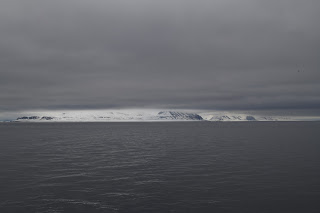Kongsfjorden
 |
| Svalbard as seen from Polarstern |
This is our easternmost and shallowest station. Researchers on board worked through the night to collect all the necessary samples – bottles of water, cores of sediment, and net tows full of plankton. Being here also afforded the opportunity for a helicopter mission to pick up samples from AWI researchers in Ny-Ålesund. As the chopper returned to the ship and we turned to steam away, fulmars glided around Polarstern. Little auks flapped their bent, angular wings, while guillemots slapped the sea surface and scooted themselves along. I feel such a peace in this place. A ferocity but also a belonging. It is swift winds and still hearts. Pounding waves and long, deep breaths. The energy of the Arctic wilderness contrasts with the calm I feel inside. Svalbard is my absolute favorite place on Earth.
We got another plankton sample back yesterday. The lander recovery went just as expected, and then Kharis and I sorted all the larvae in the lab. It took us about 7 hours, as all the samples have so far, but at least this sample came back in the morning so we got to sort during the daytime. When we finished cleaning the lab about 3 pm, we looked at each other and remarked at how civilized a work day it was.
Probably the most interesting thing from this sample was a large orange blob (well, "large" in this case is a couple hundred microns across). We had been seeing a number of similar blobs in previous samples – some orange, some peach, some white. I had assumed they were ostracod embryos, because I also found what appeared to be a young ostracod with the same approximate size and color. (Ostracods are kind of like a shrimp in a clam shell. They swim around in the water column their whole life, so they're not actually what we're looking for.) We saved the blobs anyway, just in case.
 |
| The soft coral specimen |
What we were looking at was most likely a baby soft coral. There are two kinds of soft corals in the HAUSGARTEN area (Gersemia fruticosa and Gersemia rubiformis), so it could be one of them. Soft corals are known to have big, fat, yolky larvae that don't travel very far from their parents, so that fits with our observations of the orange blobs. Like all samples we've collected this trip, we'll need to sequence the blob's DNA to be sure, but I'm pretty excited that we might have caught a soft coral larva.
Little by little, we're learning new things about larval biology in the Arctic deep sea. I'm very excited about these samples!
Comments
Post a Comment